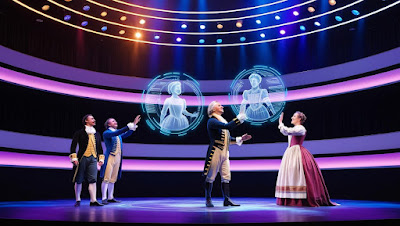Theatre in the Age of Technology: When Poets Become Engineers
Theatre in the Age of Technology:
When Poets Become Engineers
Sixty years ago, Norbert Wiener famously said, “To be successful in this new world, either the engineers must become poets, or the poets must become engineers.” This idea resonates deeply in the realm of theatre, where artists and technologists, poets and engineers collaborate to shape the future of storytelling. As we move further into the internet age, theatre continues to evolve, integrating new technologies to expand the possibilities of performance.
The Intersection of Art and Technology
The theatre has always embraced technological advancements. The actor at the heart of the play has long been supported by various innovations—candlelight, electricity, the printing press—all were once cutting-edge tools that transformed the theatre-making process. Technology has never been separate from storytelling; rather, it has been an essential part of it.
With every technological leap, new creative possibilities emerge. Today, theatres are experimenting with immersive digital environments.
The Royal Shakespeare Theatre, for example, has been scanned with millimeter accuracy using advanced lidar technology and rendered into a game engine. This means that the physical theatre now exists not only in the real world but also as a virtual 3D space.
The Rise of Smart Stages and Virtual Performance
The pandemic amplified the need for virtual and hybrid theatre experiences. Audiences craved connection, liveness, and togetherness even when physically apart. With the advent of smart stages and real-time broadcasting, theatre-makers can now redefine how performances are created and experienced. A virtual 3D space allows for more than just streaming a show—it offers an entirely new way of working together, blending the physical and digital worlds.
Arthur C. Clarke’s famous observation that “Any sufficiently advanced technology is indistinguishable from magic” is especially true in theatre. Productions like The Tempest in 2016, marking Shakespeare’s 400th anniversary, demonstrated this beautifully by incorporating augmented reality to merge the virtual with the physical. The potential for such innovations continues to grow, opening doors to new forms of creative expression.
The Future of Theatre: Where Innovation Meets Imagination
In Stratford-upon-Avon, a collaboration between poets and engineers highlighted how different creative disciplines can merge to reimagine theatre. Today, processing power allows real-time character rendering, meaning an actor’s movements can directly drive a digital avatar, bringing fantastical characters like Ariel to life in an unprecedented way.
By embracing these new technologies, theatre can push the boundaries of performance, storytelling, and audience engagement. Digital platforms provide opportunities to experiment, redefine traditional theatrical spaces, and reach global audiences. As theatre continues to evolve alongside technological advancements, it remains a driving force in shaping the cultural and artistic landscapes of the future.
In the ever-changing world of theatre, the poet and the engineer have never been separate—and as we move forward, their collaboration will only deepen. The magic of theatre lies not just in the performance but in the constant reinvention of how stories are told.
Must watch this video.
Credits: https://www.youtube.com/watch?v=PAiFYpO5UTY&t=100s
1 year MBA course Government Approved. EMI upto 6000/-. Apply now. limited seats
.jpg)
.jpg)
.jpg)




Comments
Post a Comment